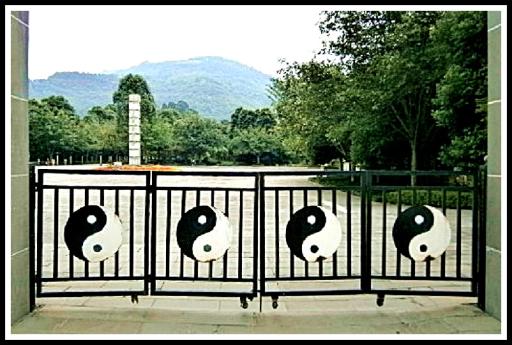Photo Essay: A Taoist Temple at the Foot of the Mountains


Photo Essay: A Taoist Temple at the Foot of the Mountains
This is another photo essay that I originally posted on the Creative Arts group more than two years ago, so I assume that not many NT members have seen it. The photos have been re-edited to better clarify them with improved presentation. Recently, a member posted an article using the yin yang symbol as its picture which made me recall this temple, as the symbol is identified as being Taoist. After touring an ancient Confucius School and an ancient village, we spent some time at this Taoist temple and palace complex. It differed from the usual Buddhist-type temples that we have seen. Taoism differs from Buddhism. In fact, on reading Journey to the West, the 2300 page classic Chinese novel written during the 16th century Ming dynasty, I learned of the rivalry between them. I can’t contribute much narrative, because I’m not that familiar with Taoism.
1 The main entrance gate. As I unfortunately experience so many times when I tour a beautiful park or an ancient site like this one, the day is very dull, with a gray sky, but the subjects are still most interesting.

2 The "yin-yang" is a common symbol in Taoism. This is a photo of the opening at the right hand side of the main gate pictured above.

3 Although that appears to be a mat, it's an inlay of different shades of pebbles.

4 While walking towards the temple we cross a river. Water is a very relevant element in Taoism. A Taoist saying is that although it is very soft it is able to wear away the hardest rock.

5 This small enclosed pagoda is to our left after we have crossed the river.

6 And in front of us is the main plaza, with LIngzu Palace up front.

7 This statue is on the left of the plaza. A member commented on the original posting of this article that the size of the little children on the left indicates the size of the statue. You will also note that cranes are also symbolic of Taoism, and you will see them elsewhere here.

8 And this one is on the right.

9 The sign for the palace of the warrior god who protects the Taoist religion and Taoist followers.

10 As you can see he is a fierce protector, a warrior god, holding up his sword.

11 There are many verdant paths to wander and meditate. The night lights each bear the yin-yang symbol

12 There are many matching-style buildings leading to the temple that you see in the background.

13 These appear to be pictures of many deities or sacred monks - unfortunately there was no English explanation.

14 To the side, these ribbons are used to hang from the trees as a sort of blessing. You will note that the tree behind the ribbon rack already has many ribbons hung from it. On my earlier posting a member pointed out this: "A lot of similarities with Shintoism. The ribbons tied on trees and racks in a Shintoism shrine are to nullify a bad fortune."

15 Inside the temple sits the Taoist warrior god - he is holding a sword. Take note of the crane at the bottom right - there is one on each side of the deity.

16 This sign is to the side of the temple, almost hidden in the underbrush. Bamboo is growing around it. Does it really say "Lord Lousy Hall"?

17 Beside the Temple is a golden wall.

18 Detail of part of the golden wall. You can see the many cranes depicted, mostly flying above.

19 I was not going to climb the pathway up to the top of the mountain. After all, it was a "stiff slope", and what if I WANTED to play? The Chinese are not always accurate in their translations. By "play" I think they mean "fool around", i.e. be careful. In a hospital I once noticed that there was a sign on a stairway that called it a "stepladder". The yin yang symbol appears on the night light as it does throughout the grounds.

20 I didn't know what these were for but again it was pointed out to be similar to Shintoism: "The medallions hanging from the rack would be wooden emma in a Shintoism shrine. Wishes are written on them."

21 This is an ancient tree. I have seen in other places where they are wrapped in red ribbons like this, and ribbons hung from them.

22 And so farewell to the Taoist Temple and its deities

23 On the way home we passed a lovely spot with a small waterfall and a shrine carved into the side of a very steep hill.

24 And just outside of it I saw a number of butterflies, and this one was huge - had about a six inch wingspan.

The most ironic thing of the day is that when we proceeded home, which took a couple of hours, the sun came out.


Still more to come, for those who are interested in another world that they will most likely never have the occasion to see with their own eyes.
Really wonderful photo essay, Buzz. I learn so much about China from them. It is such a beautiful country.
It is beautiful, but then I've been to beautiful places in America as well - what is more impressive here are the remains still existing from 5000 years of civilization.
what is more impressive here are the remains still existing from 5000 years of civilization.
Very impressive and beautiful! Thank you for sharing your part of the world!
Thank you, and as I said, there's more to come.
Obviously, I and others need to spend more time on posts like this … so, Buzz, keep posting these.
Agreed, and agreed.